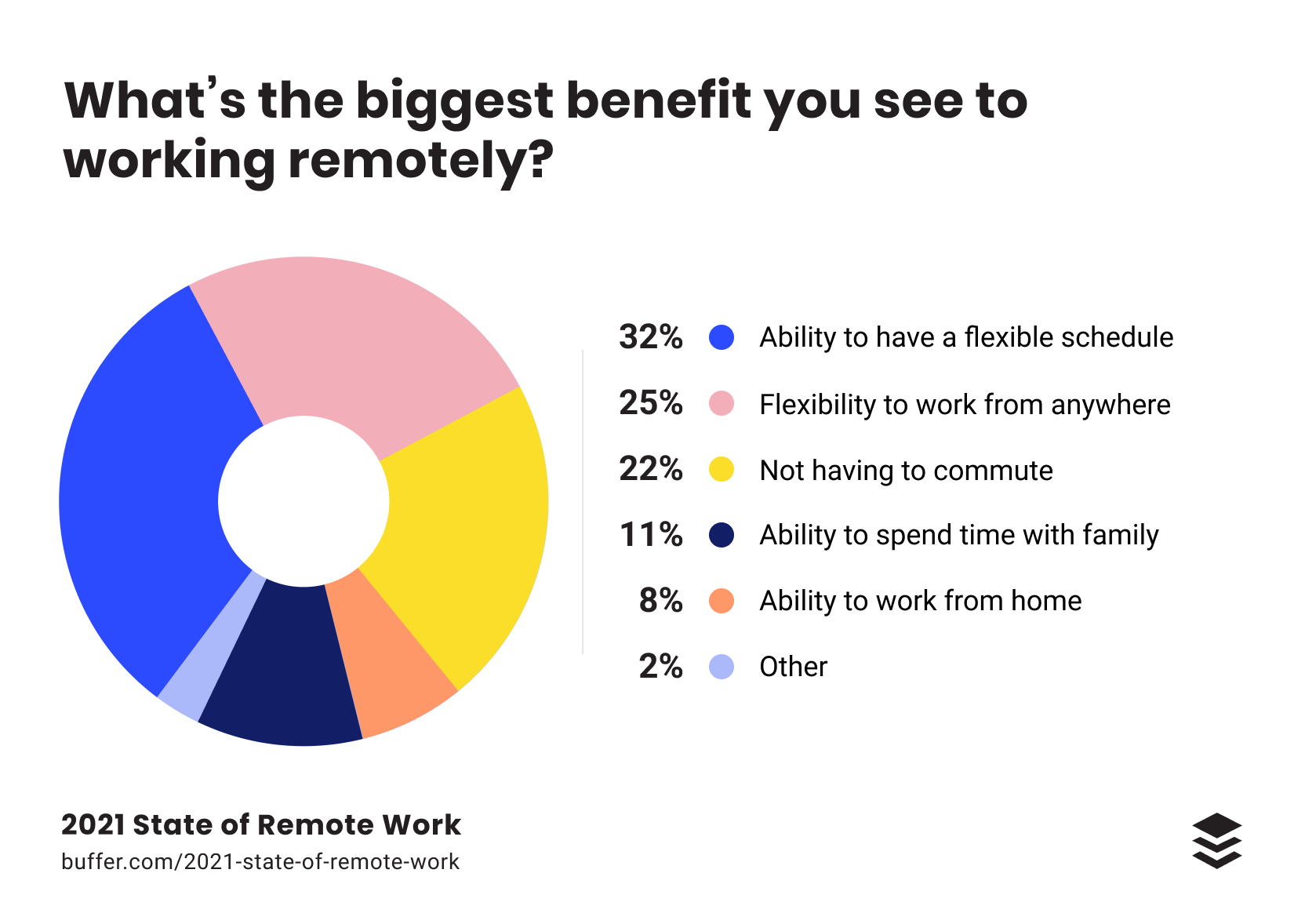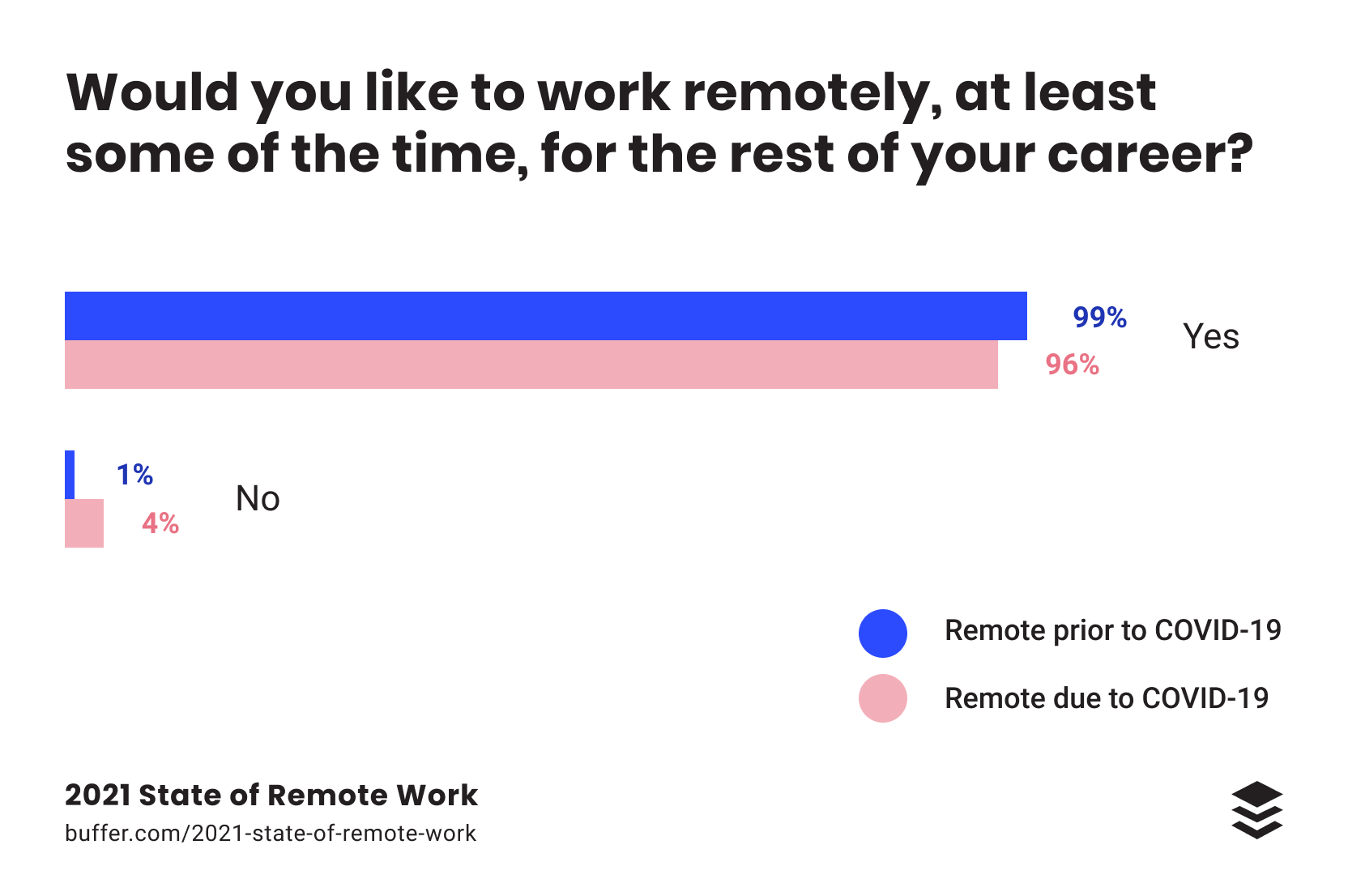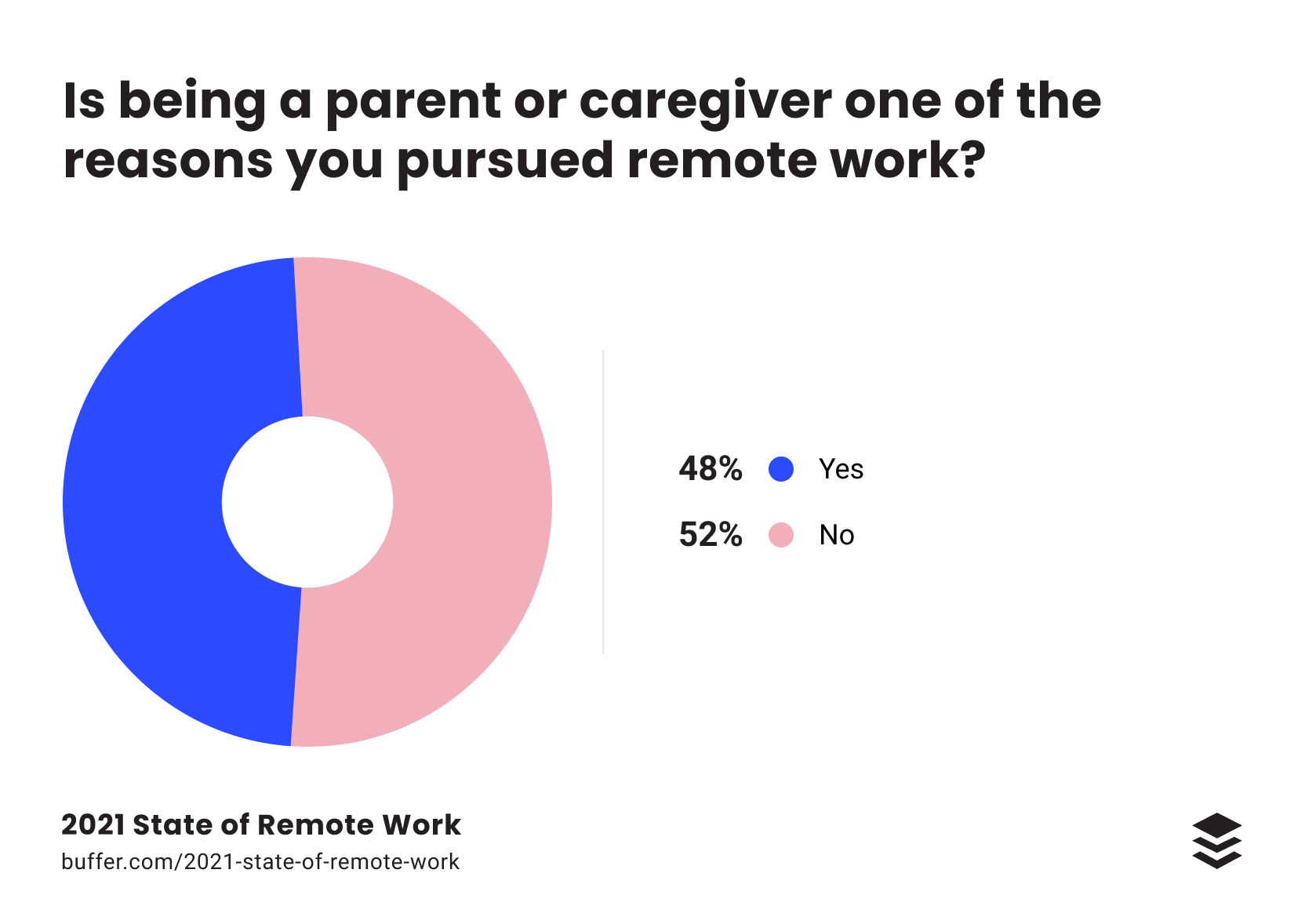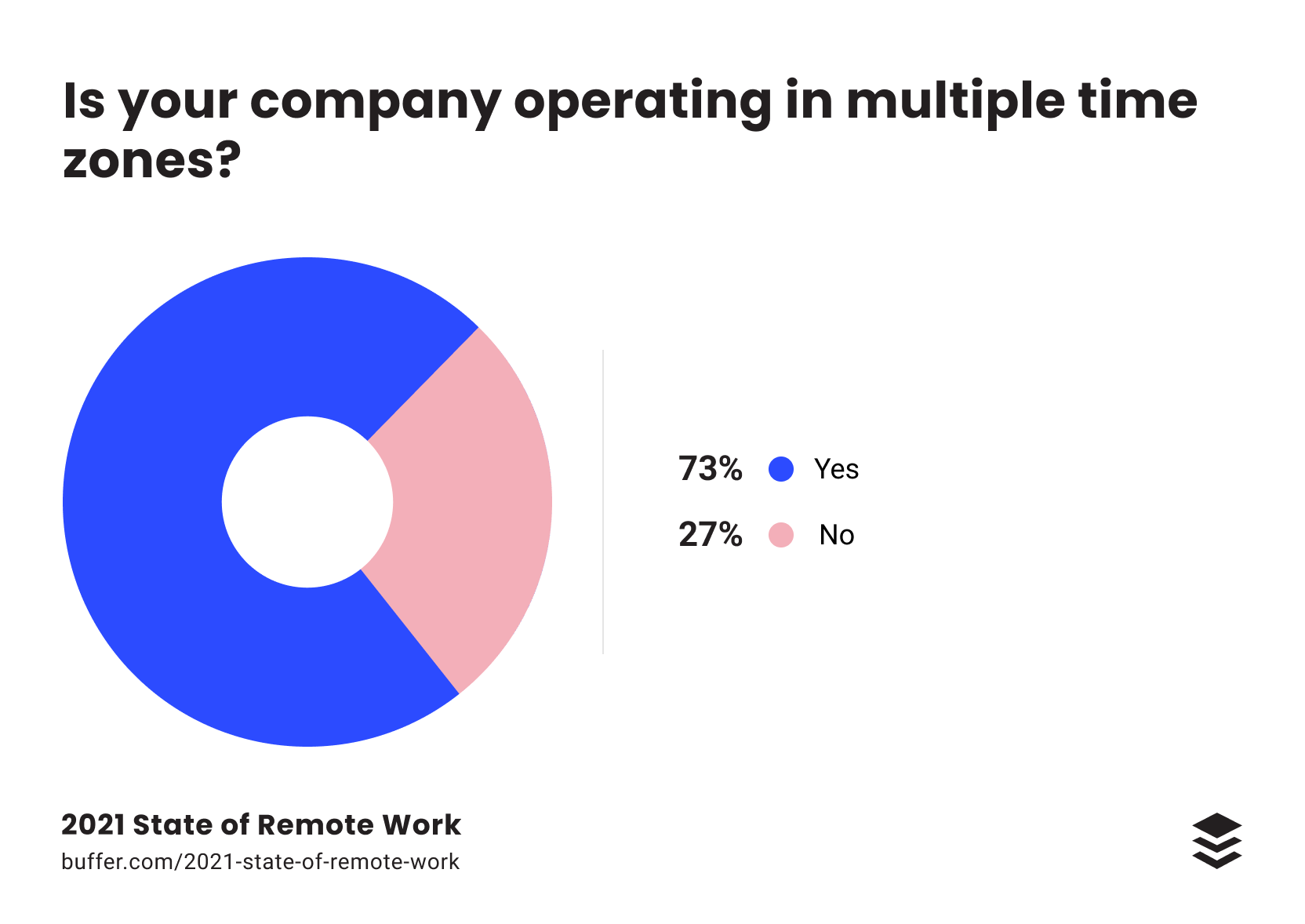Overview
The world of remote work is growing more than ever before. This year, we not only surveyed people who were remote by choice, but also people who started working remotely suddenly and during a pandemic. Forty-five percent of respondents to this year’s State of Remote Work survey are working remotely due to COVID-19 (see chart #5).
Despite nearly half of the respondents being pushed to work from home in 2020, the responses to our first two questions stayed nearly the same as in previous years when that wasn’t the case. Overwhelmingly, remote workers would like to work remotely at least some of the time for the rest of their careers (see chart #1) and, just as we’ve seen in the past few years, 97 percent of remote workers would recommend remote work to others (see chart #2).


The biggest benefit that remote workers see to working remotely remains — unquestionably — the flexibility that it offers. Thirty-two percent selected the ability to have a flexible schedule as their top benefit, followed by 25 percent who selected the flexibility to work from any location (see chart #3).
On the other hand, the biggest struggle to remote work changed quite drastically. In past years, collaboration and communication difficulties, as well as loneliness, were top of the list. This year, 27 percent of remote workers selected not being able to unplug as their biggest struggle with remote work (see chart #4), followed by difficulties with collaboration (16 percent), and loneliness (16 percent).
This increased challenge with unplugging is likely directly correlated to the number of remote workers who have been working from home instead of at the office. Despite being a popular option in past years (80 percent of remote workers in the 2020 State of Remote Work selected home as their primary work location), working from home is known to be difficult for many people. It becomes especially difficult to unplug at the end of the work day during a year where it wasn’t as possible to go see friends after work.


COVID 19 & Remote Work
There’s no doubt that COVID-19 impacted the world of remote work, so we dug into the numbers to understand the experience of folks who worked remotely due to the pandemic.
Forty-five percent of the respondents worked remotely as a result of COVID-19 (see chart #5) and 46 percent of that group said that their company was planning on permanently allowing remote work (see chart #6).
Many larger tech companies made headlines in 2020 for making the move to remote work a permanent one — including Twitter and Shopify — and as we can see from these numbers, they were not alone. Only 16 percent of respondents were certain that their company would not permanently allow remote work, while another 38 percent were still uncertain (see chart #6).


The transition to remote work was sudden for many. We heard and read stories about all of the people quickly creating space for work in their homes. Many kitchens were transformed and anything left at the office might remain there a little while. Despite the speed of the transition to remote work, 82 percent of respondents would describe their company’s transition to remote work as smooth (see chart #7).

When asked about the primary change to their work now that they work remotely, 41 percent indicated that their collaboration and communication have changed the most (see chart #8). This makes sense, as all conversations were moved online instead of relying on in-person meetings. Since the transition to remote work was overwhelmingly described as smooth, it’s likely that a lot of companies already had tool sets in place to communicate online (like Twist, Threads, or Slack) and simply began leaning into those tools more than before.
The next most popular response regarding work changes due to remote work was that 22 percent of respondents said only their location had changed, followed by 20 percent who said their work hours changed the most (see chart #8).

Insights
People overwhelmingly want to continue working remotely, even if they started working remotely due to COVID-19
This year, seeing as we can separate out those who opted in to remote work and those who did not (as a result of the pandemic), we looked at how those two groups each responded to the first two questions we always share from the report.
There is a small but noticeable 3 percent difference between how the two groups answered, which is understandable considering one group chose to work remotely while the other didn’t. With that in mind, the numbers are still overwhelmingly positive for how people see remote work. Justine Shu — the Marketing and Community Manager at We Work Remotely, a destination to find and list remote jobs — explains: “The pandemic forced many people into working from home in 2020. Even though it’s a different thing than working remotely by choice, the disruptive transition jolted the world to see the benefits of remote work.”
While 94 percent of folks who started working remotely as a result of the pandemic selected that they would like to work remotely, at least some of the time, for the rest of their career, that number jumps to 99 percent for people who were remote workers prior to COVID-19 (see chart #9).

Similarly, when asked about recommending remote work to others, 95.3 percent of people who started working remotely due to COVID-19 said that they would recommend remote work, and that number jumped to 98.3 percent when looking only at people who were remote workers before COVID-19. (see chart #10).
According to Matthew Hollingsworth, Head of Operations at We Work Remotely, “These metrics give a pretty clear picture of how remote work has become the new standard.” He goes on to share that “It shouldn’t come as any surprise that we now have a workforce who understands that many jobs can be done from anywhere, and will expect their employers to offer remote-friendly work environments. It is fundamentally shifting the way we think about work, likely on a permanent basis, and we will all be better off for it.”

While there is naturally a difference between people who opted in to remote work versus those who did not, these numbers still show a very high approval of remote work overall.
Post-pandemic remote workers love not having to commute but struggle more with collaboration and communication
The perceived top benefits and struggles of remote work are remarkably different for people who have been remote workers for a longer time compared to those who just started working remotely during the pandemic.
Most notably, for those who shifted to remote work, not having to commute was top of the benefits list, whereas seasoned remote workers highlighted a flexible schedule. This isn’t surprising to Rodolphe Dutel, founder of Remotive.io, a community of remote workers helping tech professionals go remote. The way that Rodolphe sees it is that “most workers who opted in to remote work before the pandemic wanted to enjoy a flexible schedule. Employees who started working remotely due to COVID-19 had fewer opportunities to enjoy flexible schedules due to lockdowns and sheltering in place.” He goes on to explain further: “For them, most of the upsides lie in commuting less, either for their daily commute or other business engagements (conferences, business meetings…).”
That being said, newly remote workers still very much see the benefits of flexibility: it was the second and third most popular benefits they indicated (see chart #11).

When we looked at the struggles of remote work, we could start to draw some notable insights. Both groups shared the same top struggle: not being able to unplug. Where they differed was how they ranked the difficulty with communication and collaboration. This has been a persistent struggle for remote workers and was the top reported struggle in the 2020 State of Remote Work. However, only 13 percent of them selected difficulties with collaboration and communication as their biggest struggle this year, whereas 20.5 percent of post-pandemic remote workers selected it (see chart #12). This large difference makes sense, as the organizations and individuals who were remote prior to 2020 likely had many existing processes set up whereas those transitioning to remote work had to acclimate quickly.
Other key differences between the two groups were how much they struggled with loneliness and being in a different timezone than their colleagues. For those who worked remotely before the pandemic, they reported more struggles with loneliness (17 percent compared to 14.5 percent) and working in different time zones (10 percent compared to three percent) (see chart #12). This is easily explained by the fact that teams that were previously in an office together before the pandemic likely stayed in the same timezone even after shifting to remote work.

Roughly half of the parents and caregivers surveyed pursued remote work because of their status as parents/caregivers
For the first time, we asked remote workers if they were a parent or caregiver. Within the 35 percent of respondents who are parents or caregivers (see chart #13), we were keen to learn how many of them pursued remote work specifically because of that role: nearly half (48 percent) said that they did (see chart #14).


Many of the existing benefits to remote work explored in previous sections are especially game changing for folks who are parents. Most notable, flexibility allows parents to balance work and parenting. As Karël McGrail, a Senior Software Engineer at Buffer, shared, “remote work has given me a set of additional privileges that I remember seeing my parents struggle with and it really has made mine and my families life better for it.”
Parents sometimes say they feel, as Todd Balsley, an Advocacy Lead at Buffer, put it, “torn to sacrifice an area of your life to serve another. Remote work doesn’t take away that tension, but it helps make it more manageable for my lifestyle where the commitments I juggle have overlap.” And many find that remote work allows for balance where it wouldn’t exist otherwise. As Heather-Mae Pusztai, a Customer Advocate at Buffer, explained, “Ultimately, I want the flexibility to be present in my children’s lives throughout the day while also maintaining a career that feeds my passions and goals.”
Caryn Hubbard, Buffer’s VP of Finance, specifically sought out remote work for the flexibility it would afford her in comparison to her previous work. “I chose to leave the non-remote workforce when my second child was still an infant,” she said. “After taking maternity leave, I returned to the daily grind of an in office 8-5 schedule with a 1.5 hour daily commute. The emotional and physical toll of just showing up was exhausting and the sacrifice felt personally unbearable.” In the end, she decided to leave that role. “I resigned and soon came upon a work-from-home opportunity that broadened my perspective beyond the limitations around me,” she told us.
Caryn isn’t the only one to mention the commute; Karël had a similar experience. “Part of the reason I wanted to pursue remote working was because I wanted to have more time with my family, and cutting down on commuting times meant I could have just that,” he explained.
Looking at the top benefits of remote work (see chart #3), it’s clear why roughly half of the parents and caregivers in our survey specifically pursued remote work because they are parents or caregivers.
People working remotely due to COVID-19 say they are working more and in more meetings
When we asked the respondents who became remote workers due to COVID-19 if they believe they are working more or less now that they are remote, 45 percent shared they they believe they are working more and 42 percent said they believe they are working the same amount. A small 13 percent responded that they are working less (see chart #15).
Not only are some folks working more, but over half of the respondents (52 percent) are in more meetings as a result of the shift to remote work (see chart #16). It can be deduced that many organizations started running more meetings throughout the pandemic as they worked to shift to remote work.


Buffer’s CEO, Joel Gascoigne, is hoping that these trends don’t continue. He shared, “Burnout is a big risk to those who are just working remotely for the first time, and especially to people who are now in more meetings than before. My advice to company leaders is to be aware of these trends and work to minimize burnout as much as possible by establishing processes that encourage time off of work and away from computers.” At Buffer, Joel put in place a 4-day work week in May of 2020, which started as a one-month experiment and has since become a company practice that is unlikely to change soon.
Working across time zones is the norm now and there is growing support for asynchronous communication in organizations
While only seven percent of respondents selected that being in a different time zone than their colleagues was the biggest struggle of remote work for them (see chart #4), 73 percent of all respondents shared that their company is operating in multiple time zones (see chart #17). Similarly, 74 percent of all respondents shared that people on their immediate team are in multiple time zones (see chart #18).


Most remote workers are working in teams that span across multiple time zones: nearly 60 percent of remote workers said their company operates in two to five time zones, 19 percent work in teams that span six to ten time zones, and only two percent said that their company worked in a single time zone (see chart #19).

In response to working across time zones, many in the remote work community have been outspoken about the benefits of asynchronous communication — work that doesn’t happen at the same time for everyone, e.g. on video calls. Nearly 70 percent of respondents said that their companies encouraged asynchronous communication (see chart #20).
One avid supporter of asynchronous-first communication is Amir Salihefendić, the CEO of Doist, a company that creates tools that promote a calmer way to work and live. “Support for multiple time zones is one tiny benefit of async-first,” Amir said. “The more significant benefits of async-first are that people can abolish the nine to five schedules and work at peak periods of their energy and creativity. Apart from a better life quality, async-first lets people do focused work that isn’t interrupted by pings and meetings all day long.” When it comes to the roughly 30 percent of remote workers who said that their company does not encourage asynchronous communication (see chart #20), Amir explained that “Async-first will not appeal to everyone. It requires high trust and independent people who can manage their work and remain accountable with little or no direction. Most people don’t operate with high trust or high independence.”

Parting thoughts
Our biggest takeaway from this year’s report: 2020 changed the course of remote work and we will continue to see the effects in 2021 and beyond. With millions of people experiencing long-term remote work for the first time due to COVID-19, we’re seeing an industry that will forever be altered with new tools, practices and work cultures all over the world. Some companies will never go back to in-person working, and therefore the industry is bound to continue to change and evolve over the next few years.
Now more than ever, it’s important to us at Buffer to report on the state of remote work and understand the experience of remote workers around the world. We believe a thriving remote work experience comes with greater transparency and trust and we’ll continue to champion these values as more and more companies join the remote work movement.
Thank you for taking the time to read this year’s report!
View previous reports below to compare the results:
If you are looking for a remote job we can recommend We Work Remotely or Remotive as great places to start; we are also hiring at Buffer.
For questions about this report or data, please reach out to Hailley at press@buffer.com.
The data from this report is freely available to anyone at this link. Please link back to this report if using it. You are welcome to share and republish all of the charts on this page. This data was collected between October 14th, 2020, and January 4th, 2021.
